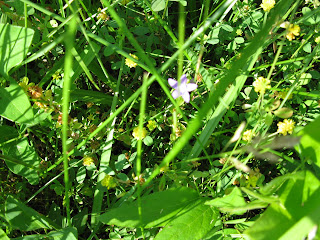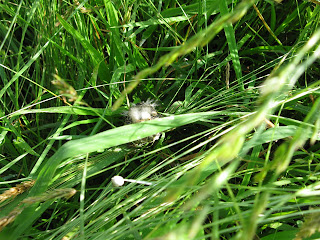Photo by Cathy Alger
Memorial Day 2008
Orwell, Vermont
My Dad was the honored Grand Marshall
Surely it must have rained on Memorial Day at times during my childhood. I don't recall that a shower or a deluge ever threatened to cancel the parade, or that the Memorial Day "exercises" at school were carried out under a sullen cloud.
Memorial Day as it was observed in the 1950's was one of the two holidays for which a school "program" was planned, practiced for, and produced for the edification of parents and neighbors. [The other holiday was Christmas.]
Every grade school teacher of the time cherished back issues of a magazine which held a storehouse of plays, pageants, drills and recitations for any season of the year.
Poems were assigned according to the memorization capacity of the dozen or so children attending a one room rural school in any given year.
In the school I attended for the first six years, the available candidates for public speaking was narrowed by the fact that half the students were from one large French Canadian family, all in various stages of struggling to learn the English language.
Using fluent English was difficult for them, but they could learn "flag drills."
I wonder now how on earth the formations of a flag drill could have been written out or illustrated.
I recall that we were lined up according to ascending heights, marched left and right, dividing and intersecting, a few moves added and practiced each day. Our feet thumped on the old wooden floor, we were admonished to keep in straight lines, to set our feet down squarely, not toeing in or out.
Eventually we learned to do the drill with the music of a scratchy victrola record and ultimately, when the teacher no longer had to watch us and bark out the measures, she played a vigorous marching tune on the old pump organ. Not til a day or two before the "program" did we get to carry the small limp American flags mounted on thin wooden dowels.
Memorization came easily to me then. My mother had been a rural school teacher herself before taking some years off to raise her daughters. I was allowed to take a copy of my "piece" home to practice, to chant as I helped dry the supper dishes. From my mother I had learned early on to stand up straight and still, to read aloud or recite clearly and [so important!] "with expression."
I was in 6th grade the spring that I undertook to learn "The Blue and The Gray."
I knew in some vague way that the poem referred to the dead of the American War Between the States, The Civil War, it was called in our history books.
I had no idea at the time that England, France, Europe, had been wracked by civil wars as well.
I had no concept of "battle-blood gory" nor yet of the anguish of conflicting loyalties which could persuade the division of states, of families, of a whole country.
I knew that filling baskets with branches of sweet-smelling lilac, watching while the biggest boys moved desks and tables to create a "stage" and a sitting area for our parents was a welcome diversion from the usual arithmetic class.
I knew that those of us who lived near the school would go home at lunch time and return for the afternoon's program. I delighted in the fact that I would wear my Sunday best summer dress with its starched bell of a skirt on a weekday.
Some of the words of the poem created mind pictures well within my grasp. I knew about "morning sun-rays" and spent my summers wandering "forests and fields."
I regularly experienced the "cooling drip of the rain."
I stood in my pretty pastel dress with my hair brushed smooth and "spoke my piece" flawlessly, unwittingly, with no concept that the poem's references must have wrenched at the hearts of any listeners, those who had served in the most recent war, who had bitter memory of "the ranks of the dead," or those who had lost a father, a brother, a sweetheart or a husband.
I can no longer recite the poem.
A few lines floated to the surface of my mind yesterday as I weeded down the long row of stringbeans, enough words so that I could readily search it out.
It is copied below.
The Blue and the Gray
By Francis Miles Finch
By the flow of the inland river,
Whence the fleets of iron have fled,
Where the blades of the grave-grass quiver,
Asleep are the ranks of the dead:
Under the sod and the dew,
Waiting the judgment-day;
Under the one, the Blue,
Under the other, the Gray.
These in the robings of glory,
Those in the gloom of defeat,
All with the battle-blood gory,
In the dusk of eternity meet:
Under the sod and the dew,
Waiting the judgment-day;
Under the laurel, the Blue,
Under the willow, the Gray.
From the silence of sorrowful hours
The desolate mourners go,
Lovingly laden with flowers
A like for the friend and the foe:
Under the sod and the dew,
Waiting the judgment-day;
Under the roses, the Blue,
Under the lilies, the Gray.
So with an equal splendor,
The morning sun-rays fall,
With a touch impartially tender,
On the blossoms blooming for all:
Under the sod and the dew,
Waiting the judgment-day;
Broidered with gold, the Blue,
Mellowed with gold, the Gray.
So, when the summer calleth,
On forest and field of grain,
With an equal murmur falleth
The cooling drip of the rain:
Under the sod and the dew,
Waiting the judgment-day;
Wet with the rain, the Blue,
Wet with the rain, the Gray.
Sadly, but not with upbraiding,
The generous deed was done,
In the storm of the years that are fading
No braver battle was won:
Under the sod and the dew,
Waiting the judgment-day;
Under the blossoms, the Blue,
Under the garlands, the Gray.
No more shall the war cry sever,
Or the winding rivers be red;
They banish our anger forever
When they laurel the graves of our dead!
Under the sod and the dew,
Waiting the judgment-day;
Love and tears for the Blue,
Tears and love for the Gray.



















































